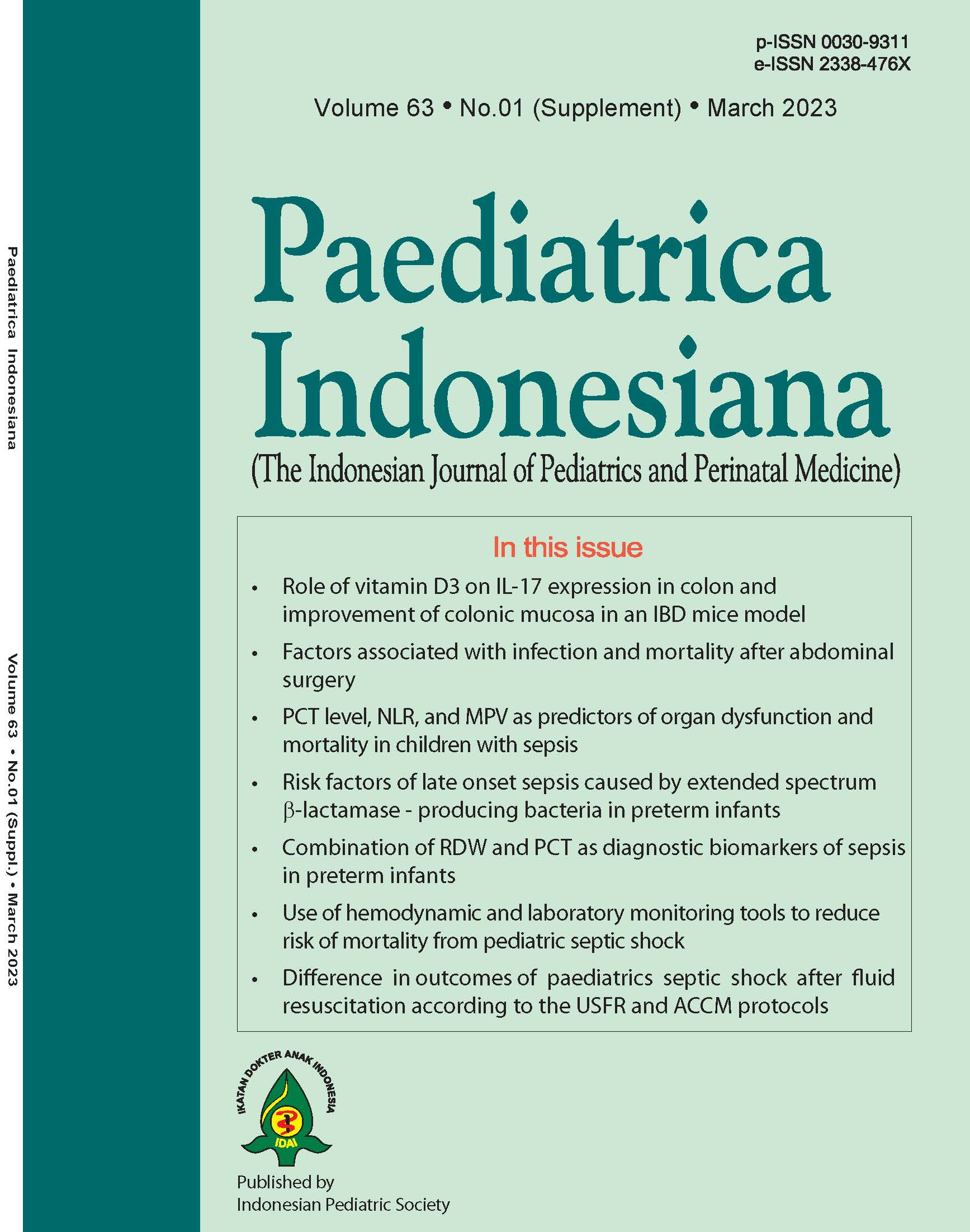Difference in outcomes of pediatric septic shock after fluid resuscitation according to the Ultrasound-guided Fluid Resuscitation (USFR) and American College of Critical Care Medicine (ACCM) protocols: A randomized clinical trial
Abstract
Background Sepsis is a major cause of morbidity and mortality in children. The American College of Critical Care Medicine (ACCM) protocol currently in use in the management of septic shock carries a risk of fluid overload. With the use of ultrasonographic monitoring, the Ultrasound-guided Fluid Resuscitation (USFR) protocol may reduce the incidence of fluid overload and mortality.
Objective To assess the difference in outcomes of fluid resuscitation in pediatric septic shock using the USFR vs. ACCM protocols.
Methods This randomized clinical trial involved 36 subjects randomized equally into the USFR and ACCM groups. After randomization, each subject was given fluid resuscitation starting at 20 mL/kg and repeated every 5-10 minutes as needed, according to the ACCM protocol. After fluid resuscitation was given, patients in the ACCM group were evaluated for clinical signs, liver span, and rhonchi, whereas those in the USFR group underwent USCOM examination for cardiac index (CI), stroke volume index (SVI), and systemic vascular resistance index (SVRI). After 60 minutes, subjects in both groups were re-assessed for clinical signs, USCOM, pulmonary edema using lung ultrasound score (LUS), and liver span. Subjects were blinded as to the protocol they received. We compared 24-hour and 72-hour mortality rates, clinical improvement of shock at 60 minutes, cardiac index (CI), stroke volume index (SVI), and systemic vascular resistance index (SVRI), as well as pulmonary edema and hepatomegaly, between the two groups.
Results At 60 minutes after resuscitation, there were significant differences between the ACCM and USFR groups in the proportion of clinical improvement (0/18 vs. 5/18, P=0.016), pulmonary edema (15/18 vs. 4/18, P<0.001), and hepatomegaly (16/18 vs. 5/18, P<0.001). Mortality rates at 24 hours and 72 hours in the ACCM vs. USFR groups were 17% vs. 12% (P=0.199) and 78% vs. 39% (P=0.009), respectively.
Conclusion The USFR protocol reduces the occurrence of fluid overload and leads to a lower mortality rate at 72 hours compared to the ACCM fluid resuscitation protocol.
References
2. Ikatan Dokter Anak Indonesia. Konsensus diagnosis dan tatalaksana sepsis pada anak. Jakarta: Badan Penerbit IDAI, 2016. p. 1-16.
3. Davis AL, Carcillo JA, Aneja RK, Deymann AJ, Lin JC, Nguyen TC, et al. American College of Critical Care Medicine - Clinical practice parameter for hemodynamic support of pediatric and neonatal septic shock. Crit Care Med. 2017;45:1061-93. DOI: https://doi.org/10.1097/CCM.0000000000002425.
4. Maitland K, Kiguli S, Opoka RO, Engoru C, Olupot-Olupot P, Akech SO, et al. Mortality after fluid bolus in African children with severe infection. N Engl J Med. 2011;364:2483-95. DOI: https://doi.org/10.1056/NEJMoa1101549.
5. Ranjit S, Aram G, Kissoon N, Ali MK, Natraj R, Shresti S, et al. Multimodal monitoring for hemodynamic categorization and management of pediatric septic shock: a pilot. Pediatr Crit Care Med. 2014;15:e17-26. DOI: https://doi.org/10.1097/PCC.0b013e3182a5589c.
6. Wang Y, Sun B, Yue H, Lin X, Li B, Yang X, et al. An epdemiologic survey of pediatric sepsis in regional hospitals in China. Pediatr Crit Care. 2014;15:814-20. DOI: https://doi.org/10.1097/PCC.0000000000000247.
7. Rusmawatiningtyas D, Nurnaningsih N. Mortality rates in pediatric septic shock. Paediatr Indones. 2023;56:304-10. DOI: https://doi.org/10.14238/pi56.5.2016.304-10.
8. Gandhi J, Sangareddi S, Varadarajan P, Suresh S. Pediatric Index of Mortality 2 score as an outcome predictor in pediatric intensive care unit in India. Indian J Crit Care Med. 2013;17:288-91. DOI: https://doi.org/10.4103/0972-5229.120320.
9. Slater A, Shann F, & Pearson G. PIM2: a revised version of the Paediatric Index of Mortality. Intensive Care Medicine. 2003;29:278–285. DOI: https://doi.org/10.1007/s00134-002-1601-2.
10. Via G, Storti E, Gulati G, Neri L, Mojoli F, Braschi A. Lung ultrasound in the ICU: from diagnostic instrument to respiratory monitoring tool. Minerva Anestesiol. 2012;78:1282-96. PMID: 22858877.
11. Yuan J, Yang X, Yuan Q, Li M, Chen Y, Dong C. Systematic review of ultrasound-guided fluid resuscitation vs. early goal directed therapy in patients with septic shock. Zhonghua Wei Zhong Bing Ji Jiu Yi Xue. 2020;32:56-61. DOI: https://doi.org/10.3760/cma.j.cn121430-20191114-00010.
12. Gelbart B. Fluid bolus therapy in pediatric sepsis: current knowledge and future direction. Front Pediatr. 2018;6:308. DOI: https://doi.org/10.3389/fped.2018.00308.
13. Long E, Babl FE, Oakley E, Sheridan B, Duke T, Pediatric Research in Emergency Departments International Collaborative (PREDICT). Cardiac index changes with fluid bolus therapy in children with sepsis-an observational study. Pediatr Crit Care Med. 2018;19:513-8. DOI: https://doi.org/10.1097/PCC.0000000000001534.
Copyright (c) 2023 Saptadi Yuliarto, Kurniawan T. Kadafi, Nelly Pramita Septiani

This work is licensed under a Creative Commons Attribution-NonCommercial-ShareAlike 4.0 International License.
Authors who publish with this journal agree to the following terms:
Authors retain copyright and grant the journal right of first publication with the work simultaneously licensed under a Creative Commons Attribution License that allows others to share the work with an acknowledgement of the work's authorship and initial publication in this journal.
Authors are able to enter into separate, additional contractual arrangements for the non-exclusive distribution of the journal's published version of the work (e.g., post it to an institutional repository or publish it in a book), with an acknowledgement of its initial publication in this journal.
Accepted 2023-03-31
Published 2023-03-31













